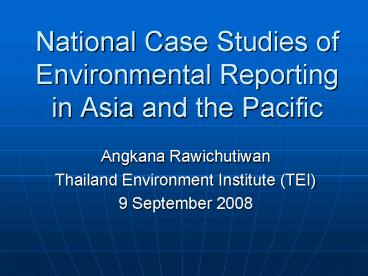National Case Studies of Environmental Reporting in Asia and the Pacific - PowerPoint PPT Presentation
1 / 23
Title:
National Case Studies of Environmental Reporting in Asia and the Pacific
Description:
Environmental assessment in Asia and the Pacific. National state of environment (SoE) reporting process in 11 countries: China, ... – PowerPoint PPT presentation
Number of Views:76
Avg rating:3.0/5.0
Title: National Case Studies of Environmental Reporting in Asia and the Pacific
1
National Case Studies of Environmental Reporting
in Asia and the Pacific
- Angkana Rawichutiwan
- Thailand Environment Institute (TEI)
- 9 September 2008
2
Outline
- Regional overview
- National case studies
- China
- Thailand
- Pakistan
3
Regional Overview
- Environmental assessment in Asia and the Pacific.
- National state of environment (SoE) reporting
process in 11 countries China, Japan, Thailand,
Vietnam, Pakistan, Bhutan, Kazakhstan,
Turkmenistan, Australia, New Zealand, and Samoa.
4
Key areas
- The legal basis and historical background
- The scope, content, and conceptual framework
- The uses and constraints of SoE reporting in
public communication and policy making
5
Regional Overview
- The diversity of the result reflects
- the institutional agreements within the
countries - the difference in legislative or policy
requirements and - the various constraints each country faces
6
1. Assessment and reporting frameworks
- Legal basis
- Required by national environmental legislation
China, Japan, Thailand, Vietnam, Pakistan,
Bhutan, and Australia - General obligation Kazakhstan, Turkmenistan, and
Samoa - No specific legislation New Zealand
- The 1998 Aarhus Convention parties Kazakhstan
and Turkmenistan
7
1. Assessment and reporting frameworks (cont.)
- History of reporting
- Japan 1972
- Australia 1986
- Most countries 1990s
- Frequency of reporting
- Every 5 years Australia and New Zealand
- Every year China, Japan, Thailand, and Vietnam
- One report Pakistan (in 2005)
8
2. Coverage and dissemination
- Thematic and issue-based reporting
- Theme-based China, Pakistan, Bhutan, Kazakhstan,
Turkmenistan, Australia, and New Zealand. - Issue-based Japan
- Both Thailand, Vietnam, and Samoa.
9
2. Coverage and dissemination (cont.)
- Conceptual frameworks and indicators
- Pressure-State-Response (PSR) framework.
- Driver-Pressure-State-Impact-Response (DPSIR)
framework. - No explicit framework or adapted framework.
- Language
- Dissemination
10
3. Uses
- SoE reports do not contain any recommendations
China, Kazakhstan, Turkmenistan, and New Zealand. - SoE reports contain recommendations Thailand,
Vietnam, Pakistan, Bhutan, Australia, and Samoa.
11
4. Constraints
- In preparing the reports
- Financial and technical weakness.
- A lack of accurate, national consistent
environmental data. - A lack of an agreed set of national environmental
indicators. - Limited human and financial resources.
12
4. Constraints (cont.)
- In response to the recommendations and findings
- Inconsistencies in environmental laws and
application - Weak monitoring and enforcement
- A lack of proper economic incentives
- The integration of environmental concerns into
wider sectoral policies is incomplete.
13
The examples of national case studies of
environmental reporting
- 1. China
- 2. Thailand
- 3. Pakistan
14
China (Northeast Asia)
- Assessment and reporting framework
- Article 11 of Chinas Environmental Protection
Law. - Since 1991, the Ministry of Environmental
Protection (MEP) has published SoE reports
yearly. - SoE reports are structured on the
Stress-Status-Response conceptual framework and
are available on the internet.
15
China (cont.)
- 2. Findings and recommendations
- Chinas SoE report of 2006, released in 2007.
- The overall environmental quality has remained
stable. - The report does not contain any recommendations.
16
China (cont.)
- 3. Policy responses
- Limited use as a decision-making tools.
- 4. Constraints
- Responsibilities for data collection, management,
and dissemination are scattered. - The level of integration of different information
sources is still weak.
17
Thailand (Southeast Asia)
- Assessment and reporting framework
- It is required by environmental legislation that
SoE report be submitted at least once a year. - SoE reports are theme-based and structured on
Pressure-State-Response framework. - The reports are available on the internet.
18
Thailand (cont.)
- 2. Findings and recommendations
- SoE report of 2006 states overall decline in
Thailands environment and makes numerous
recommendations. - 3. Policy responses
- Framed by the National Environmental Quality
Management Plan (EQMP) for 2007 2011.
19
Thailand (cont.)
- 4. Constraints
- A lack of financial and technical capacity in
data organizing, processing, and reporting. - A lack of continuity and clear goals in
government policies.
20
Pakistan (South Asia)
- 1. Assessment and reporting framework
- An annual national SoE report is required to be
prepared and published by the 1997 Pakistan
Environmental Protection Act. - Only one SoE report is produced in 2005 due to
resource constraints. - The report is theme-based and structured on the
Pressure-State-Impact-Response (PSIR) framework.
21
Pakistan (cont.)
- 2. Findings and recommendations
- SoE report of 2005 identifies key environmental
issues of concern water quality and
availability and air quality. - The report makes a series of recommendations
focusing on the resource, capacity, and knowledge
constraints.
22
Pakistan (cont.)
- 3. Policy responses
- Framed by the National Environmental Policy (NEP)
for 2005-2015. - 4. Constraints
- Gaps in institutional design the regulatory
framework and incentives and accountability. - Capacity limitations.
23
Thank you































